Bond-Slip Performances of Ultra-High Performance Concrete Steel Tube Columns Made of a Large-Diameter Steel Tube with Internally Welded Steel Bars
Abstract
:1. Introduction
2. Specimen Design and Test Scheme
2.1. Test Specimen Design
2.2. Experimental Program
2.2.1. Loading Scheme
2.2.2. Layout of Measurement Sensors
3. Test Results and Analysis
3.1. Test Phenomena and Failure Patterns
3.2. Main Results of the Test
3.3. Interpretation of the Results
3.4. Strain Distribution
4. Finite Element Simulation
4.1. Constitutive Model of the Materials
4.2. Boundary Conditions and Meshing
4.3. Modelling of the Interfaces between the Steel Tube and UHPC
4.4. Comparative Analysis of Interfacial Bond Strength
4.5. Validation of the Finite Element Model
5. Calculation of Ultimate Bearing Capacity
5.1. Equation for Calculating Ultimate Bearing Capacity
5.2. Comparison of the Calculated and Test Values
6. Conclusions
- (1)
- The bond strength and energy dissipation capacity of the interface of a large-diameter UHPC-FSTC can be considerably improved by adding welded steel bars, with the number of steel rings increasing, the bond strength of the interface also increases and the energy dissipation capacity first increases and then decreases.
- (2)
- A comparison of the construction measures of the steel-tube UHPC columns in this study shows that construction measure R2 has the best relative performance, with a bond strength increase of approximately 50 times and an energy dissipation capacity increase of approximately 30 times compared to R0 that does not have any construction measures.
- (3)
- A finite element model of UHPC-FSTC specimens with internally welded steel bars was established. The simulation results agreed with the test results in terms of the load-displacement curves, failure modes, and ultimate bearing capacities, thereby proving the applicability of the model. The interface bond strength analysis showed that the welded steel rings inside the steel tubes substantially increased the interface-bearing capacities of the UHPC-FSTCs. The welded spiral bar inside the steel tube improved the interfacial stress distribution.
- (4)
- The method for determining the ultimate bearing capacities of the interfaces of UHPC–FSTCs with internally welded steel bars presented in this study is highly accurate. The calculated values agree with the test values. These results provide a reference for future research on the mechanical properties of UHPC-FSTCs.
- (5)
- Our findings afford valuable insights for advancing engineering applications of UHPC-FST members, including their use in arch rings for large-span arch bridges, piers, foundations of cross-sea bridges, and deep-water pier foundations. Compared with ordinary CFST, UHPC-FST members have smaller cross-sections and lighter weight. Furthermore, internal welding reinforcement structures increase interfacial bond strength, thus mitigating the debonding problem and improving load-bearing capacity and durability.
- (6)
- To explore the application prospects of UHPC-FSTCs in marine environments, the effects of salt corrosion and temperature on the interfacial bonding of steel-tube UHPC columns will also be studied.
Author Contributions
Funding
Institutional Review Board Statement
Informed Consent Statement
Data Availability Statement
Conflicts of Interest
References
- Johansson, M. Composite Action and Confinement Effects in Tubular Steel-Concrete Columns; Chalmers University of Technology: Gothenburg, Sweden, 2002. [Google Scholar]
- Han, L.H.; Li, W.; Bjorhovde, R. Developments and advanced applications of concrete-filled steel tubular (CFST) structures: Members. J. Constr. Steel Res. 2014, 100, 211–228. [Google Scholar] [CrossRef]
- Song, G. Study on Restraint Effect and Axial Compression Behavior of Large Diameter Concrete Filled Steel Tube; Xihua University: Chengdu, China, 2020. [Google Scholar]
- Deng, L. Study on Ultimate Bearing Capacity of Large Diameter Concrete-Filled Steel Tube Members; Chongqing Jiaotong University: Chongqing, China, 2021. [Google Scholar]
- Chen, Z.; Xu, W.; Zhou, J. Mechanical performance of marine concrete filled CFRP-aluminum alloy tube columns under axial compression: Experiment and finite element analysis. Eng. Struct. 2022, 272, 114993. [Google Scholar] [CrossRef]
- Xue, J.; Briseghella, B.; Huang, F.; Nuti, C.; Tabatabai, H.; Chen, B. Review of ultra-high performance concrete and its application in bridge engineering. Constr. Build. Mater. 2020, 260, 119844. [Google Scholar] [CrossRef]
- Richard, P.; Cheyrezy, M. Composition of reactive powder concretes. Cement. Concrete Res. 1995, 25, 1501–1511. [Google Scholar] [CrossRef]
- Richard, P.; Cheyrezy, M. Reactive powder concretes with high ductility and 200–800 MPa compressive strength. ACI Spec. Publ. 1994, 144, 507–518. [Google Scholar]
- Du, J.; Meng, W.; Khayat, K.H.; Bao, Y.; Guo, P.; Lyu, Z.; Abu-obeidah, A.; Nassif, H.; Wang, H. New development of ultra-high-performance concrete (UHPC). Compos. Part B Eng. 2021, 224, 109220. [Google Scholar] [CrossRef]
- Liu, G.; Qian, Z.; Xue, Y. Comprehensive feasibility evaluation of a high-performance mixture used as the protective course of steel bridge deck pavement. Constr. Build. Mater. 2022, 322, 126419. [Google Scholar] [CrossRef]
- Sharma, R.; Jang, J.G.; Bansal, P.P. A comprehensive review on effects of mineral admixtures and fibers on engineering properties of ultra-high-performance concrete. J. Build. Eng. 2022, 45, 103314. [Google Scholar] [CrossRef]
- Zhang, R.; Chen, S.; Gu, P.; Huang, Y. Structural behavior of UHPC filled steel tubular columns under eccentric loading. Thin Wall. Struct. 2020, 156, 106959. [Google Scholar] [CrossRef]
- Liew, J.Y.R.; Xiong, D.X. Ultra-High Strength Concrete Filled Composite Columns for Multi-Storey Building Construction. Adv. Struct. Eng. 2012, 15, 1487–1503. [Google Scholar] [CrossRef]
- Xiong, M.X.; Xiong, D.X.; Liew, J.Y.R. Behaviour of steel tubular members infilled with ultra high strength concrete. J. Constr. Steel Res. 2017, 138, 168–183. [Google Scholar] [CrossRef]
- Hoang, A.L.; Fehling, E. A review and analysis of circular UHPC filled steel tube columns under axial loading. Struct. Eng. Mech. 2017, 62, 417–430. [Google Scholar] [CrossRef]
- Guler, S.; Copur, A.; Aydogan, M. Axial capacity and ductility of circular UHPC-filled steel tube columns. Mag. Concr. Res. 2013, 65, 898–905. [Google Scholar] [CrossRef]
- Xiong, M.X.; Xiong, D.X.; Liew, J.Y.R. Axial performance of short concrete filled steel tubes with high- and ultra-high-strength materials. Eng. Struct. 2017, 136, 494–510. [Google Scholar] [CrossRef]
- Chen, S.M.; Zhang, R.; Jia, L.J.; Wang, J.Y.; Gu, P. Structural behavior of UHPC filled steel tube columns under axial loading. Thin Wall. Struct. 2018, 130, 550–563. [Google Scholar] [CrossRef]
- Wei, J.G.; Xie, Z.T.; Zhang, W.; Luo, X.; Yang, Y.; Chen, B.C. Experimental study on circular steel tube-confined reinforced UHPC columns under axial loading. Eng. Struct. 2021, 230, 111599. [Google Scholar] [CrossRef]
- Hu, J.Y.; Huang, Y.F.; Li, W.J.; Zhang, S.S.; Rao, S. Compressive behaviour of UHPC-filled square high-strength steel tube stub columns under eccentric loading. J. Constr. Steel Res. 2022, 198, 107558. [Google Scholar] [CrossRef]
- Wu, F.H.; Zeng, Y.Q.; Li, B.; Lyu, X.T. Experimental Investigation of Flexural Behavior of Ultra-High-Performance Concrete with Coarse Aggregate-Filled Steel Tubes. Materials 2021, 14, 6354. [Google Scholar] [CrossRef]
- Fang, H.; Gu, M.; Zhang, S.; Jiang, H.; Fang, Z.; Hu, J. Effects of Steel Fiber and Specimen Geometric Dimensions on the Mechanical Properties of Ultra-High-Performance Concrete. Materials 2022, 15, 3027. [Google Scholar] [CrossRef]
- Wu, Z.; Shi, C.; Khayat, K.H. Investigation of mechanical properties and shrinkage of ultra-high performance concrete: Influence of steel fiber content and shape. Compos. Part B Eng. 2019, 174, 107021. [Google Scholar] [CrossRef]
- Zhang, C.Y. Research on the Interfacial Bond-Slip Behavior of Reactive Powder Concrete (RPC) Filled Circular Steel Tubes Columns; Xi’an University of Architecture and Technology: Xi’an, China, 2019. [Google Scholar]
- Wang, J.L. Research on Bond-Slide Performance of CRC-Filled Steel Tube; Inner Mongolia University of Science and Technology: Baotou, China, 2021. [Google Scholar]
- Gao, C.Y.; Yuan, M.M.; Wang, J.L.; Sun, K.Q.; Zhao, N. Research on interfacial bond-slip mechanical properties of ultra-high performance concrete filled steel tube. Build. Struct. 2022, 52, 1369–1374. [Google Scholar] [CrossRef]
- Wang, L.; Chen, H.; Zhong, J.; Chen, H.; Xuan, W.; Mi, S.; Yang, H. Study on the Bond-Slip Performance of CFSSTs Based on Push-Out Tests. Adv. Mater. Sci. Eng. 2018, 2018, 2959827. [Google Scholar] [CrossRef]
- Wang, Q.W.; Liu, L.; Shi, Q.X.; Wang, P. A calculation method of interface bond strength of reactive powder concrete filled in steel tubes. Eng. Mech. 2020, 37, 41–50. [Google Scholar] [CrossRef]
- Wang, Q.W.; Shi, Q.X.; Xu, Z.D.; Zhang, C.Y. Interface bond-slip behavior of reactive powder concrete-filled circular steel tube. J. Build. Struct. 2021, 42, 210–218. [Google Scholar] [CrossRef]
- Liu, L. Research on the Interfacial Bonding-Slip Behavior of Ultra High Performance Concrete Filled Square Steel Tubes; Xi’an University of Architecture and Technology: Xi’an, China, 2020. [Google Scholar]
- Wu, B.; Tan, Z.; Zhang, Y.; Zhao, Z.; Liu, C. Experimental Research on the Bond-Slip Behavior of Red Mud Concrete Filled Square Steel Tubes. IOP Conf. Ser. Mater. Sci. Eng. 2018, 394, 032016. [Google Scholar] [CrossRef]
- Yan, Y.; Xu, L.; Li, B.; Chi, Y.; Yu, M.; Zhou, K.; Song, Y. Axial behavior of ultra-high performance concrete (UHPC) filled stocky steel tubes with square sections. J. Constr. Steel Res. 2019, 158, 417–428. [Google Scholar] [CrossRef]
- Cao, X.; Xie, X.D.; Zhang, T.Y.; Du, G.F. Bond-slip behavior between high-strength steel tube and Ultra-high Performance Concrete. Structures 2023, 47, 1498–1510. [Google Scholar] [CrossRef]
- Shakir-Khalil, H. Resistance of concrete-filled steel tubes to push-out forces. Struct. Eng. 1993, 71, 234–243. [Google Scholar]
- Roeder, C.W.; Cameron, B.; Brown, C.B. Composite Action in Concrete Filled Tubes. J. Struct. Eng. 1999, 125, 477–484. [Google Scholar] [CrossRef]
- Xu, K.C.; Huang, C.L.; Chen, M.C. Research on impact of steel tube inner surface roughness on interfacial bonding behavior of CFST. J. Build. Struct. 2013, 34, 420–424. [Google Scholar]
- Chen, L.H.; Dai, J.X.; Jin, Q.L.; Sheng, B.L. Push-out test study on the bond strength between square checkered steel tube and concrete. Build. Struct. 2015, 45, 17–20+26. [Google Scholar] [CrossRef]
- Tao, Z.; Song, T.Y.; Uy, B.; Han, L.H. Bond behavior in concrete-filled steel tubes. J. Constr. Steel Res. 2016, 120, 81–93. [Google Scholar] [CrossRef]
- Ronanki, V.S.; Aaleti, S.; Valentim, D.B. Experimental investigation of bond behavior of mild steel reinforcement in UHPC. Eng. Struct. 2018, 176, 707–718. [Google Scholar] [CrossRef]
- Dong, H.; Chen, X.; Cao, W.; Zhao, Y. Bond-slip behavior of large high-strength concrete-filled circular steel tubes with different constructions. J. Constr. Steel Res. 2020, 167, 105951. [Google Scholar] [CrossRef]
- GB/T228.1–2010; Metallic Materials-Tensile Testing—Part 1: Method of Test at Room Temperature. China Standard Press: Beijing, China, 2010. (In Chinese)
- GB/T 50081–2002; Standard for Test Method of Mechanical Properties on Ordinary Concrete. China Standard Press: Beijing, China, 2013. (In Chinese)
- Chen, Z.P.; Li, J.C.; Zhou, J. Axial compressive behavior of built-in carbon-steel marine concrete-filled stainless steel tubular columns. J. Constr. Steel Res. 2023, 202, 107796. [Google Scholar] [CrossRef]
- Zhang, G.C.; Guo, C.Q.; Yan, Z.K.; Zhou, Y.; Zuo, X.Q. Quasi-Static Compression Deformation Mode, Mechanical Property and Energy Absorption Performance of Steel Foam Filled Tubes. Mater. Rev. 2021, 35, 24158–24163. [Google Scholar]
- Han, L.H.; Zhao, X.L.; Tao, Z. Tests and mechanics model for concrete-filled SHS stub columns, columns and beam-columns. Steel Compos. Struct. 2001, 1, 51–74. [Google Scholar] [CrossRef]
- Wang, Q.W.; Liang, L.; Lui, E.M.; Shi, Q.X. Behavior of eccentrically loaded UHPC filled circular steel tubular short columns. J. Constr. Steel Res. 2022, 193, 107282. [Google Scholar] [CrossRef]
- Liu, W. Interfacial failure analysis based on cohesive zone model. Comput. Aided Eng. 2013, 22, 456–460. [Google Scholar]
- Li, B.J.; Jiang, J.L.; Deng, Z.H.; Zhou, H.Y.; Wang, H.C.; Jiang, H.T.; Cao, Y.D. Bending behavior of steel-UHPC composite bridge deck based on epoxy adhesive. Front. Mater. 2022, 9, 1023886. [Google Scholar] [CrossRef]
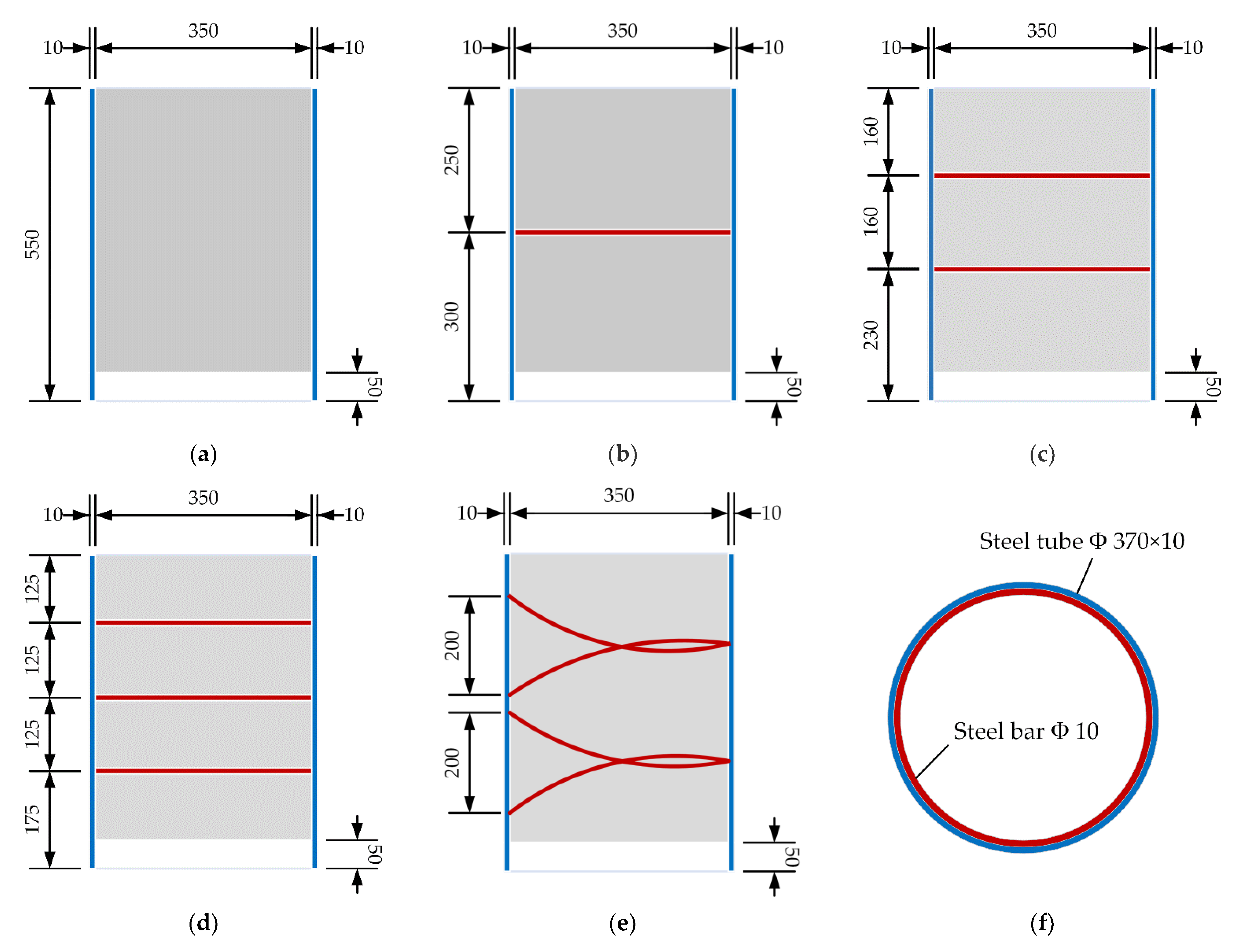

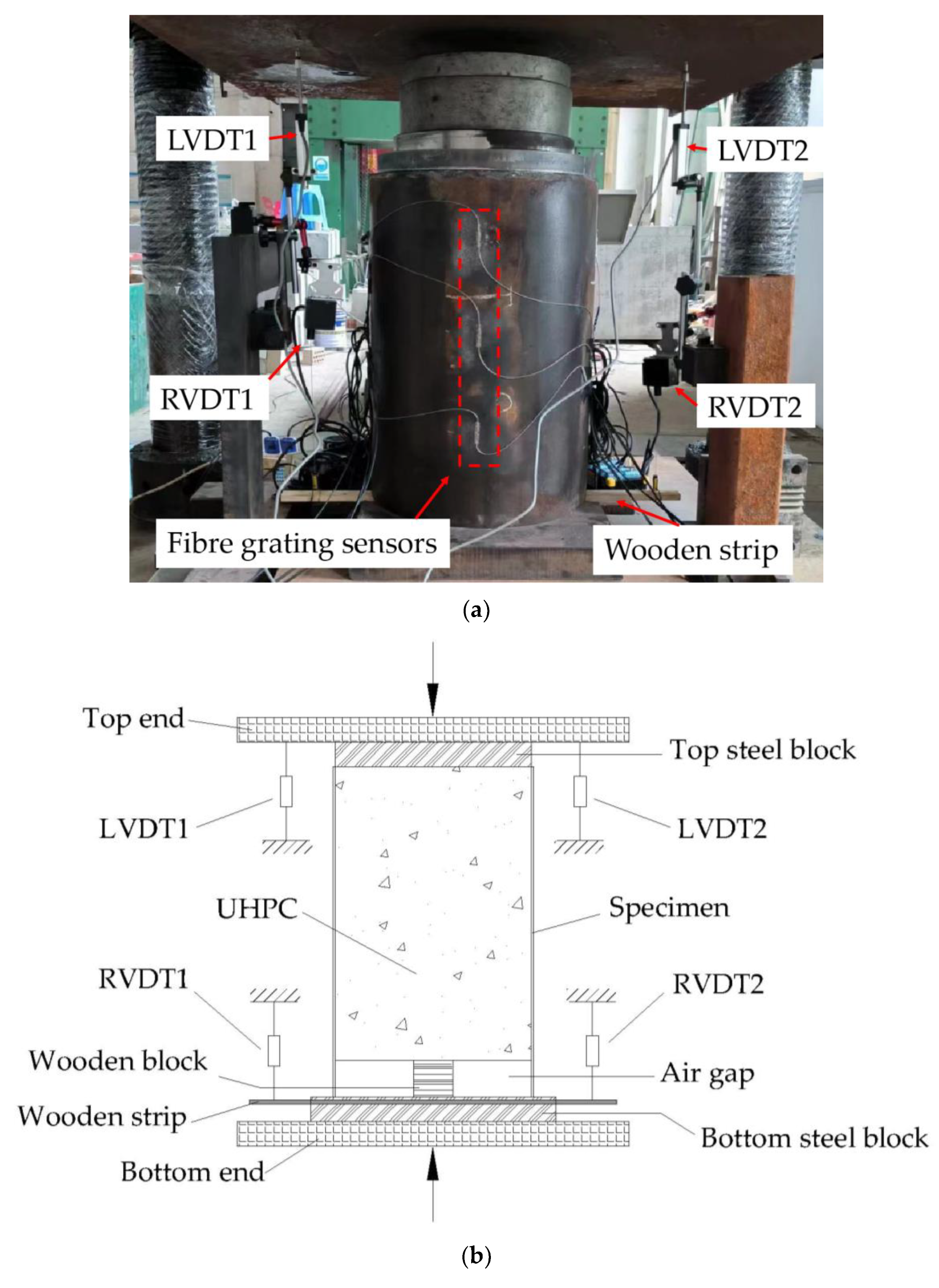

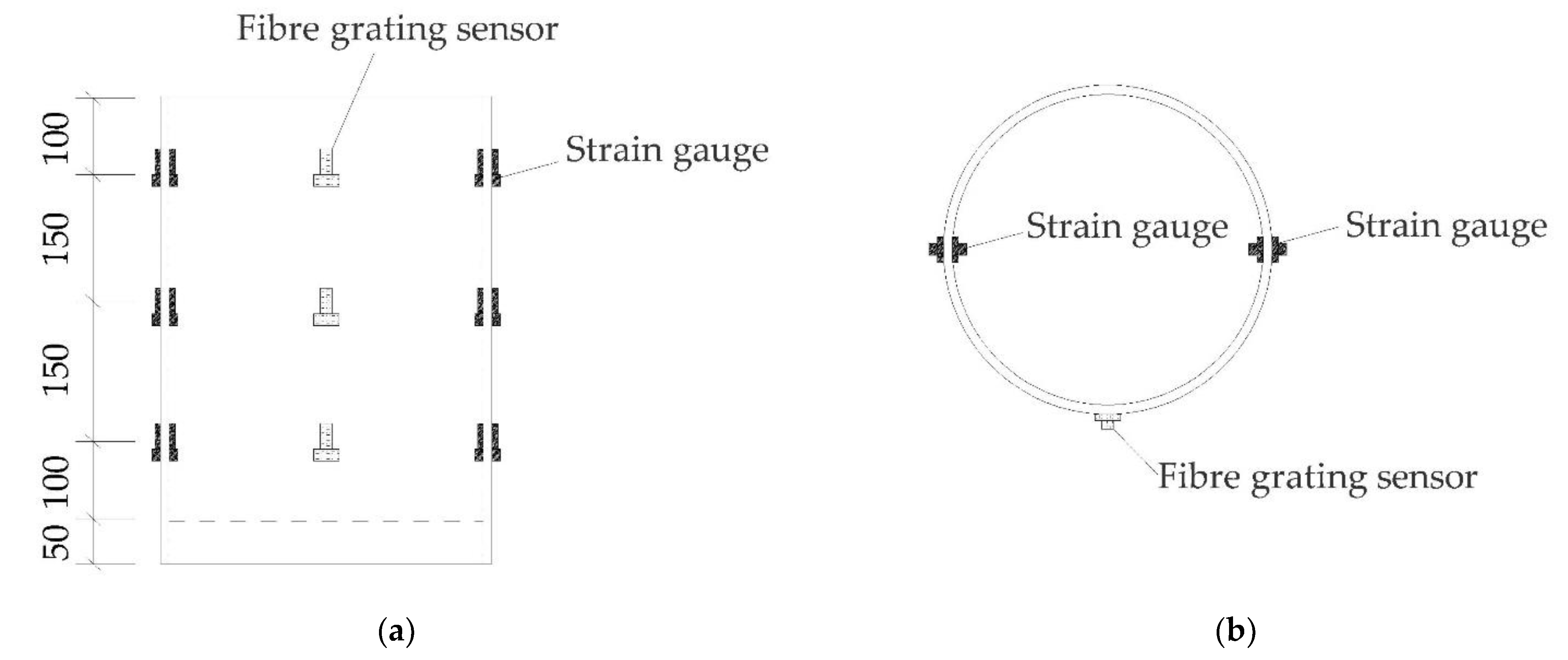
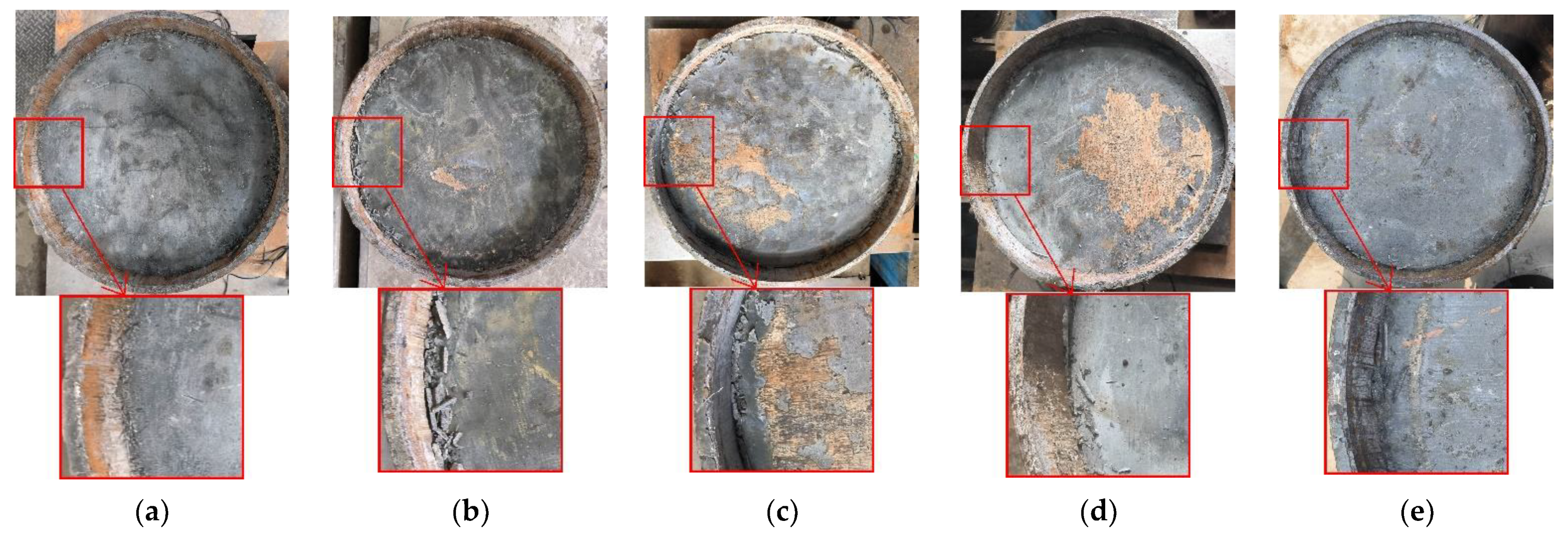
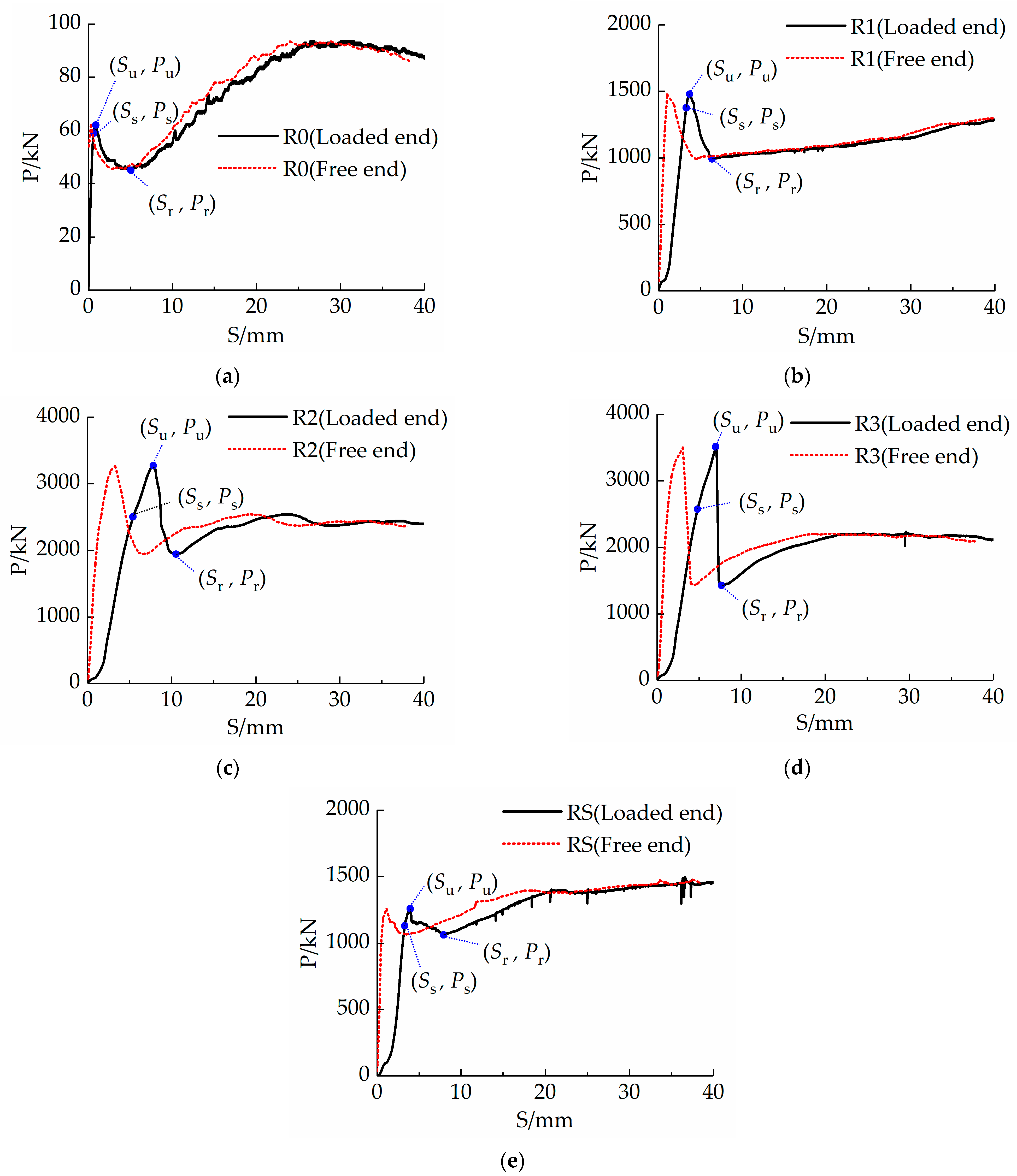
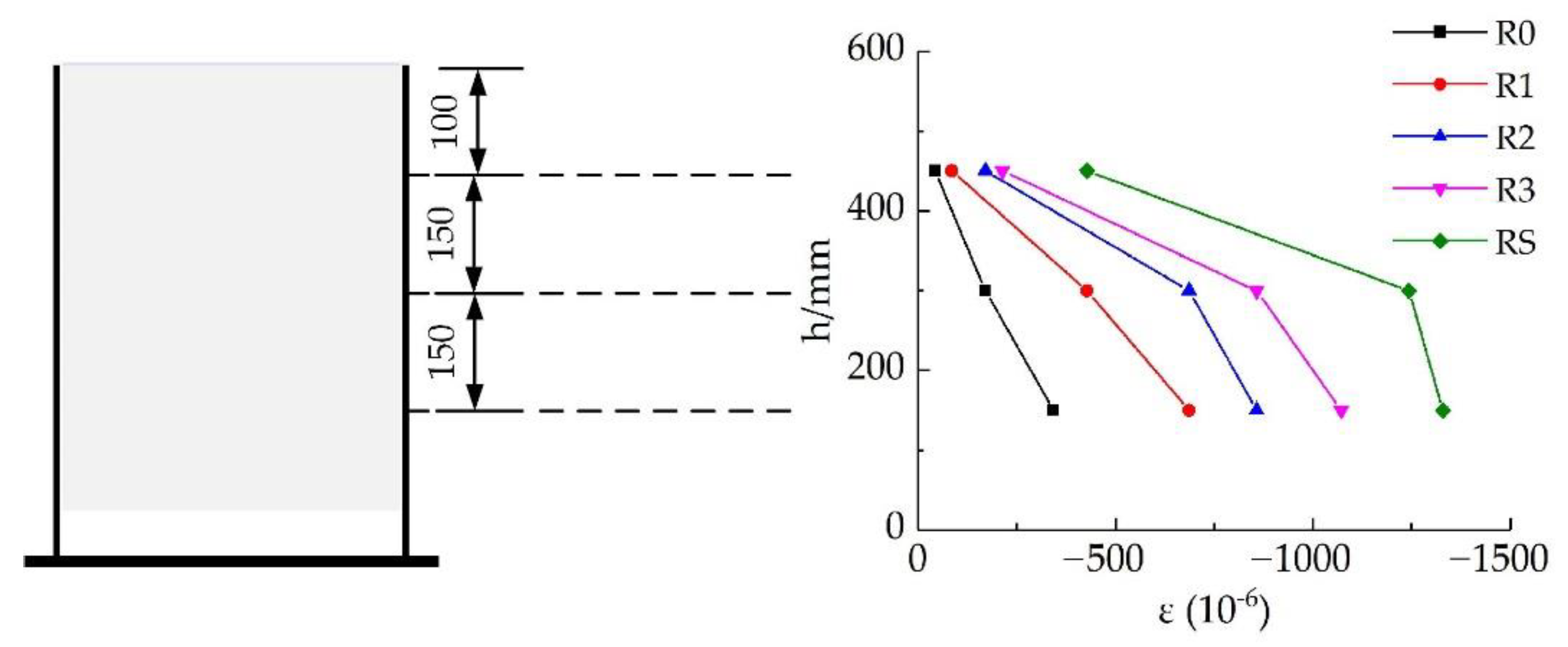
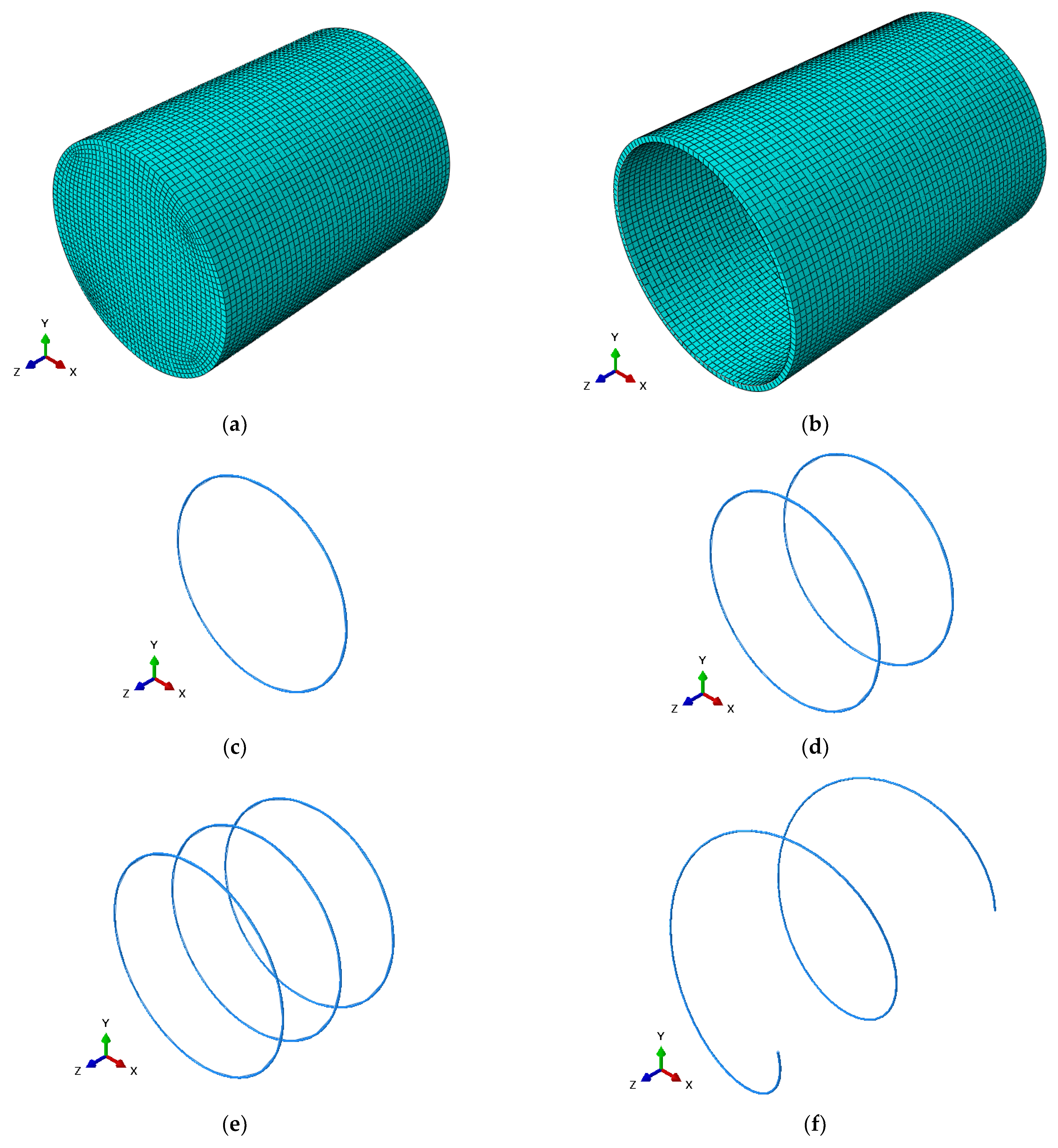
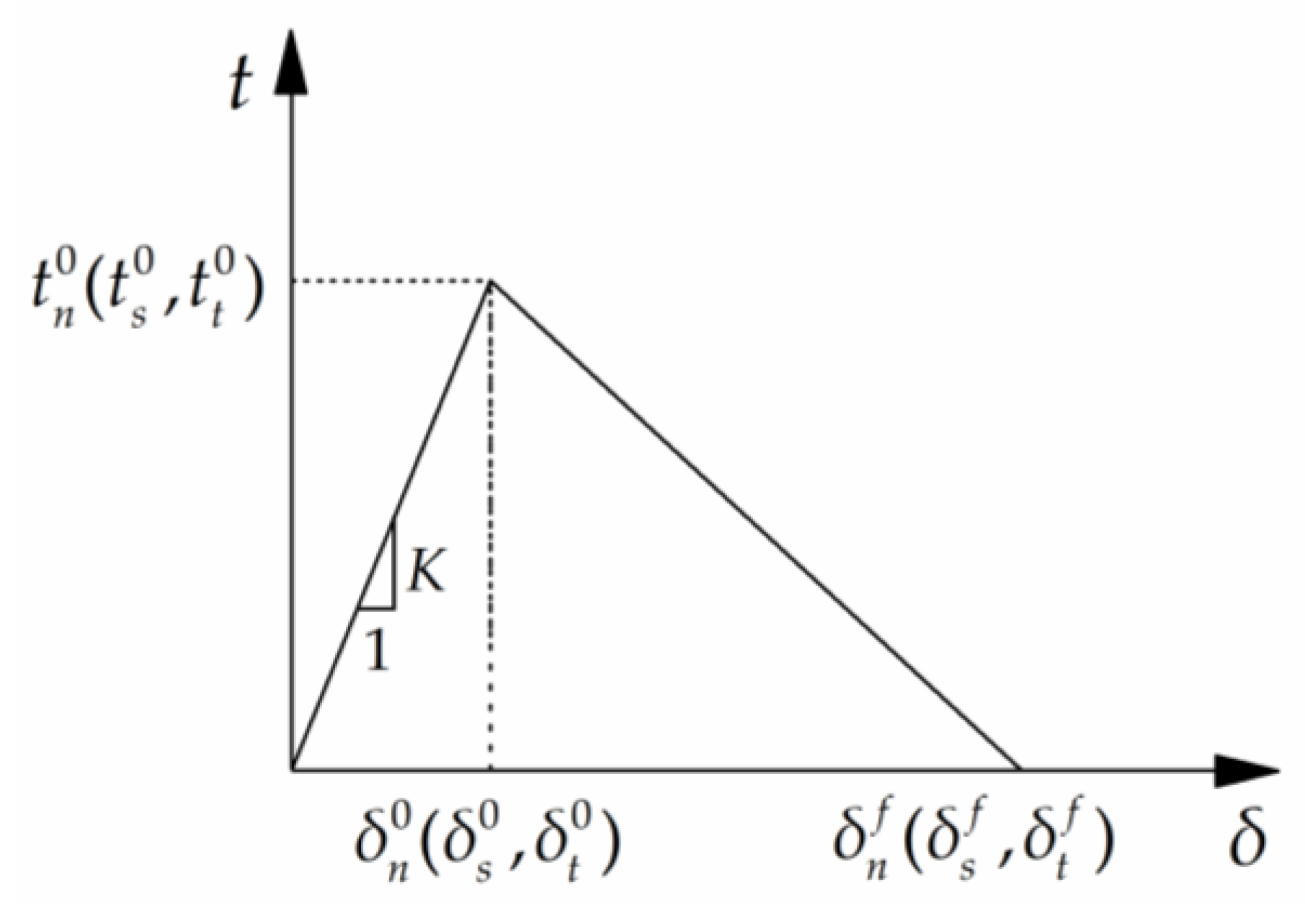
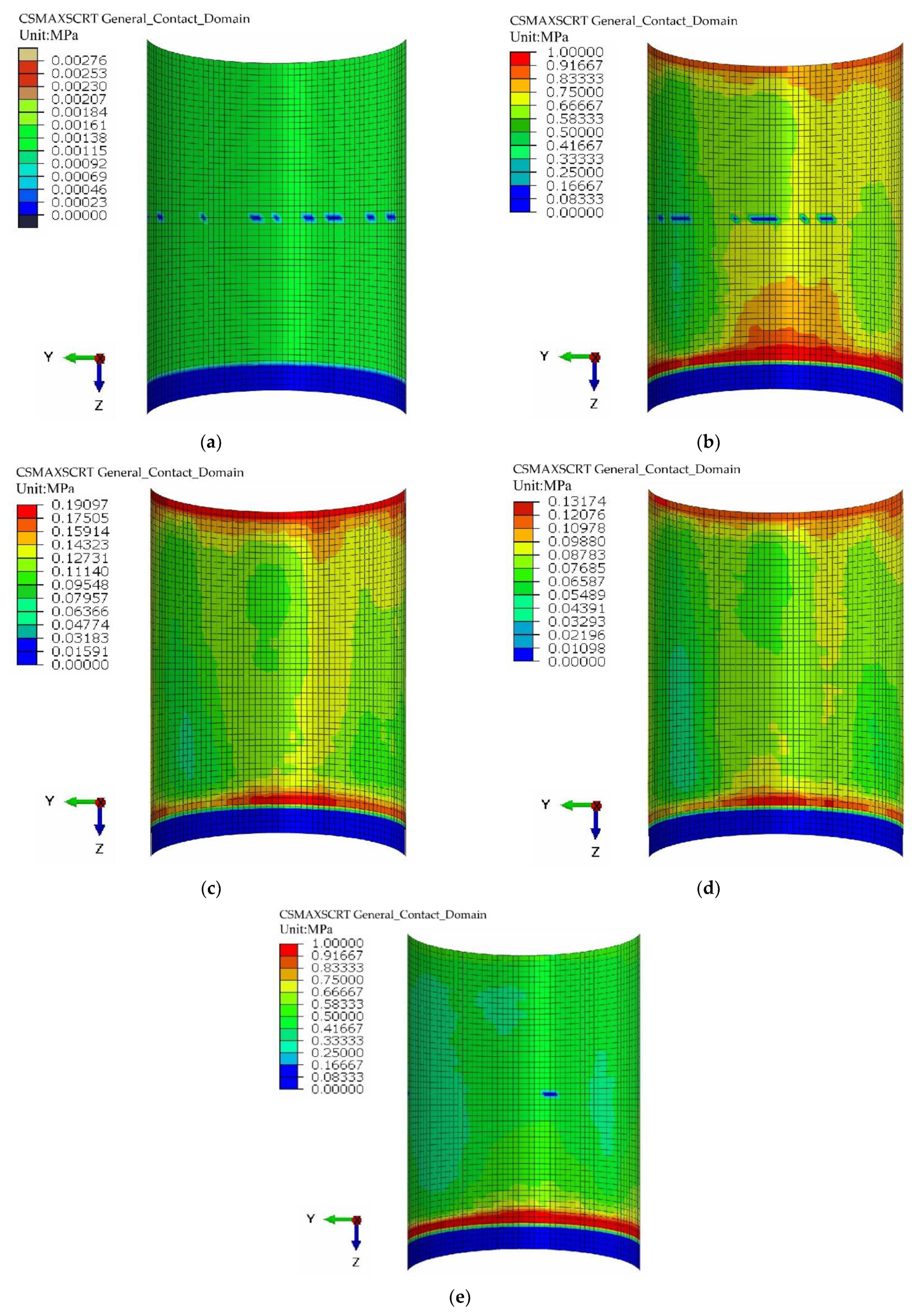
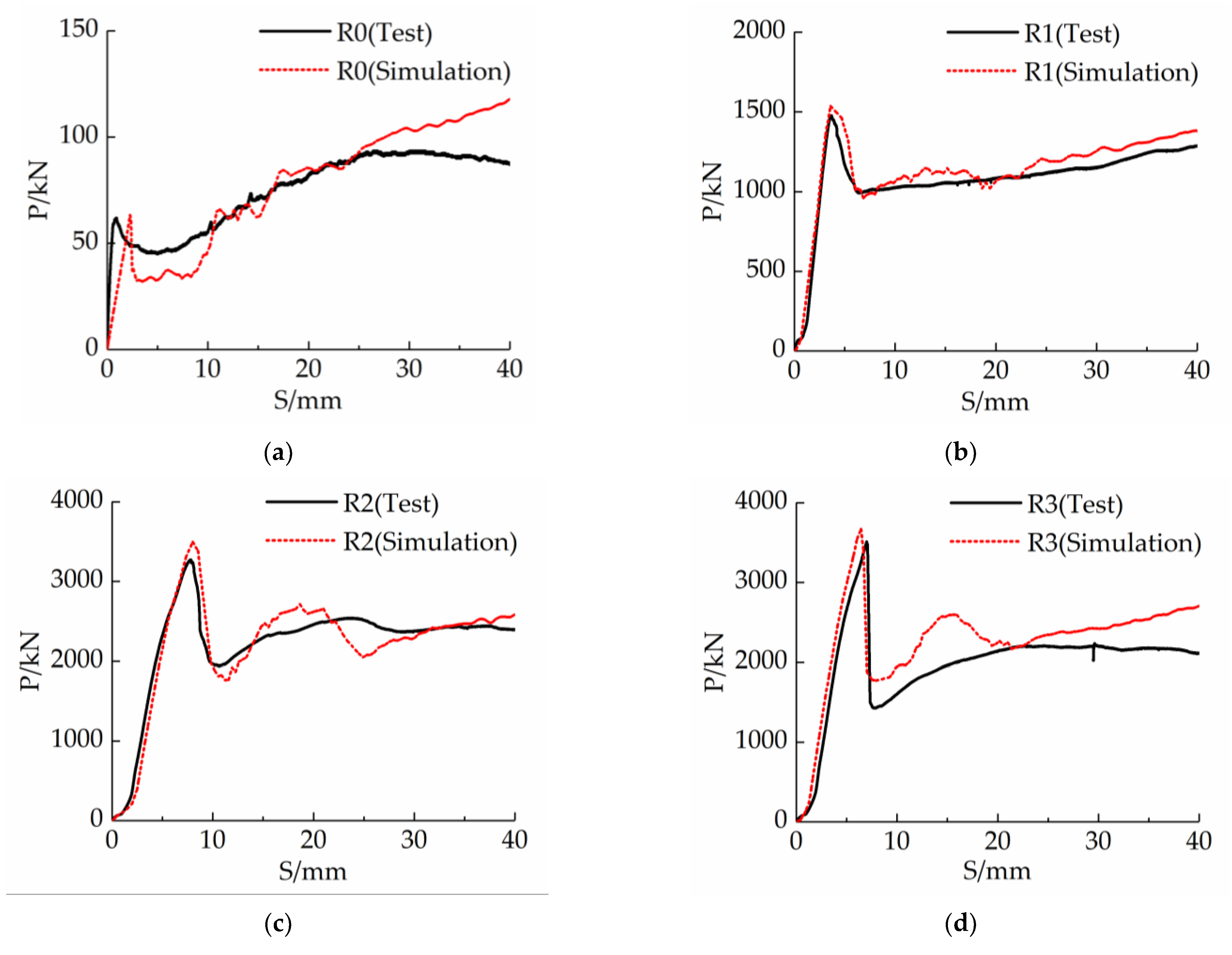
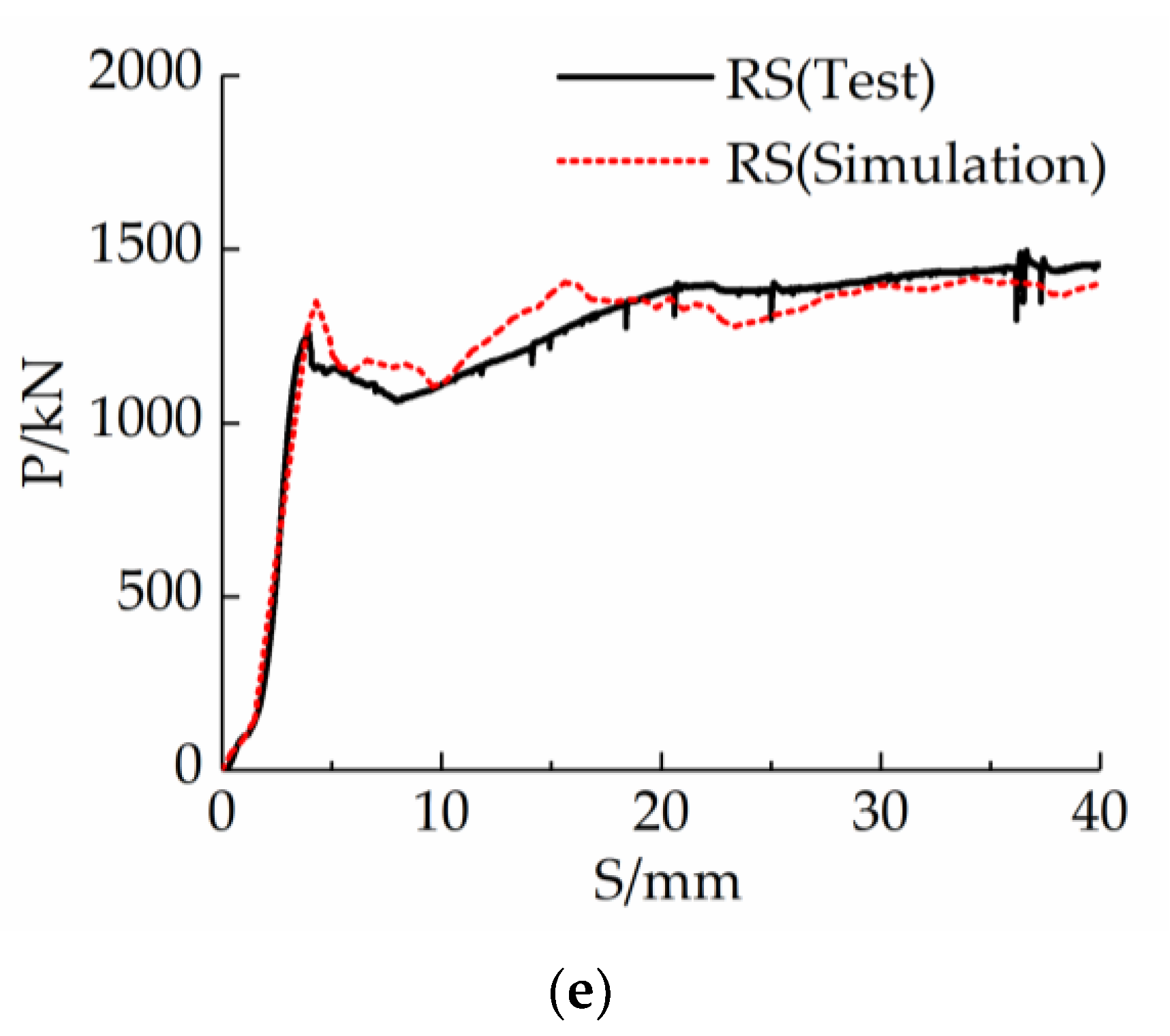
| Specimen ID | Core Concrete | Specimen Size D × t × l (mm) | Interfacial Bond Length (mm) | Number of Steel Rings (pcs) | Number of Spiral Bars (pcs) | Stirrup Spacing (mm) |
|---|---|---|---|---|---|---|
| R0 | UHPC | 370 × 10 × 550 | 500 | 0 | 0 | - |
| R1 | UHPC | 370 × 10 × 550 | 500 | 1 | 0 | @250 |
| R2 | UHPC | 370 × 10 × 550 | 500 | 2 | 0 | @160 |
| R3 | UHPC | 370 × 10 × 550 | 500 | 3 | 0 | @125 |
| RS | UHPC | 370 × 10 × 550 | 500 | 0 | 1 | @200 |
| Size (mm) | Position | fy (MPa) | fu (MPa) | Es (MPa) | δ (%) |
|---|---|---|---|---|---|
| 10 | Steel tube | 235 | 380 | 2.00 × 105 | 25 |
| 10 | Steel bar | 300 | 425 | 1.98 × 105 | 10 |
| Premix | River Sand | Water Reducer | Water | Steel Fibre |
|---|---|---|---|---|
| 1150.8 | 920.6 | 13 | 184.7 | 181 |
| Specimen ID | Ps (kN) | Pu (kN) | Pr (kN) | Ss (mm) | Su (mm) | Sr (mm) | Δ1 (mm) | Δ2 (mm) | Δ3 (mm) | α1 | α2 |
|---|---|---|---|---|---|---|---|---|---|---|---|
| R0 | 58.5 | 61.5 | 45 | 0.58 | 0.82 | 5.05 | 0.52 | 0.63 | 0.78 | 0.95 | 0.73 |
| R1 | 1448.5 | 1475.5 | 991.5 | 3.48 | 3.71 | 6.45 | 2.46 | 2.41 | 2.06 | 0.98 | 0.67 |
| R2 | 2565.5 | 3273.5 | 1940.5 | 5.59 | 7.82 | 10.67 | 3.96 | 4.52 | 4.07 | 0.78 | 0.59 |
| R3 | 2725.7 | 3512.3 | 1426.5 | 5.13 | 7.01 | 7.74 | 3.61 | 3.93 | 3.72 | 0.78 | 0.41 |
| RS | 1186.5 | 1258.5 | 1062.5 | 3.48 | 3.94 | 7.91 | 3.53 | 2.82 | 4.43 | 0.94 | 0.84 |
| Specimen ID | R0 | R1 | R2 | R3 | RS |
|---|---|---|---|---|---|
| τs (MPa) | 0.11 | 2.63 | 4.67 | 4.96 | 2.16 |
| τu (MPa) | 0.11 | 2.68 | 5.95 | 6.39 | 2.29 |
| τr (MPa) | 0.08 | 1.80 | 3.53 | 2.59 | 1.93 |
| Specimen ID | R0 | R1 | R2 | R3 | RS |
|---|---|---|---|---|---|
| W (kN∙m) | 1.630 | 25.186 | 52.915 | 46.271 | 28.058 |
| Ws (kN∙m) | 0.024 | 1.727 | 5.697 | 5.157 | 1.113 |
| Wu (kN∙m) | 0.039 | 2.322 | 12.613 | 11.349 | 1.896 |
| Wr (kN∙m) | 0.244 | 5.531 | 19.077 | 12.775 | 6.404 |
| Specimen ID | Tested Values (kN) | Simulated Values (kN) | Tested Values/Simulated Values | Error (%) |
|---|---|---|---|---|
| R0 | 61.5 | 63.26 | 0.97 | 2.78 |
| R1 | 1475.5 | 1535.94 | 0.96 | 3.94 |
| R2 | 3273.5 | 3498.19 | 0.94 | 6.42 |
| R3 | 3512.3 | 3670.47 | 0.96 | 4.31 |
| RS | 1258.5 | 1354.94 | 0.93 | 7.12 |
| Average Error | 4.91 | |||
| Specimen ID | Test Values (kN) | Calculated Values (kN) | Calculated Values/Test Values |
|---|---|---|---|
| R0 | 61.5 | 61.50 | 1.000 |
| R1 | 1475.5 | 1471.98 | 0.998 |
| R2 | 3273.5 | 3367.31 | 1.029 |
| R3 | 3512.3 | 3675.86 | 1.047 |
| RS | 1258.5 | 1236.90 | 0.983 |
| Average value of the ratio | 1.001 | ||
| Standard deviation of the ratio | 0.0231 | ||
| coefficient of variance of the ratio | 0.0229 | ||
Disclaimer/Publisher’s Note: The statements, opinions and data contained in all publications are solely those of the individual author(s) and contributor(s) and not of MDPI and/or the editor(s). MDPI and/or the editor(s) disclaim responsibility for any injury to people or property resulting from any ideas, methods, instructions or products referred to in the content. |
© 2023 by the authors. Licensee MDPI, Basel, Switzerland. This article is an open access article distributed under the terms and conditions of the Creative Commons Attribution (CC BY) license (https://creativecommons.org/licenses/by/4.0/).
Share and Cite
Deng, N.; Zhao, H.; Yao, D.; Tang, Z. Bond-Slip Performances of Ultra-High Performance Concrete Steel Tube Columns Made of a Large-Diameter Steel Tube with Internally Welded Steel Bars. Materials 2023, 16, 3836. https://doi.org/10.3390/ma16103836
Deng N, Zhao H, Yao D, Tang Z. Bond-Slip Performances of Ultra-High Performance Concrete Steel Tube Columns Made of a Large-Diameter Steel Tube with Internally Welded Steel Bars. Materials. 2023; 16(10):3836. https://doi.org/10.3390/ma16103836
Chicago/Turabian StyleDeng, Nianchun, He Zhao, Dunrong Yao, and Zhiyu Tang. 2023. "Bond-Slip Performances of Ultra-High Performance Concrete Steel Tube Columns Made of a Large-Diameter Steel Tube with Internally Welded Steel Bars" Materials 16, no. 10: 3836. https://doi.org/10.3390/ma16103836






